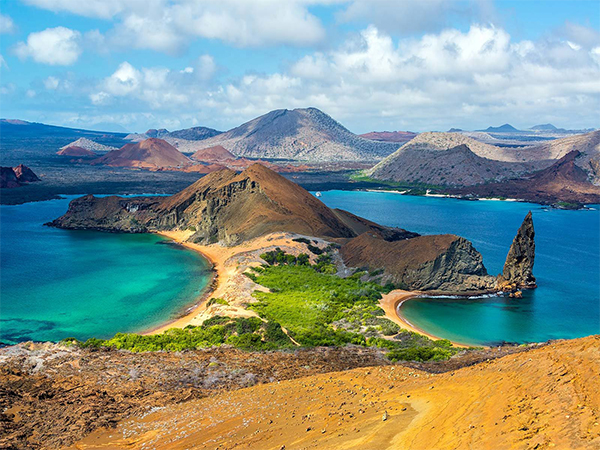Ecuador – Affordable Dentists, Quality Clinics

Introduction
Ecuador, officially the Republic of Ecuador, which literally translates as "Republic of the Equator", is also a booming player when it comes to affordable dental services and premium clinics. Ecuador also includes the Galápagos Islands in the Pacific and the capital city is Quito, while the largest city is Guayaquil. The historic center of Quito has one of the largest, least-altered and best-preserved historic centers in the Americas. Quito, Kraków, and Poland were the first World Cultural Heritage Sites declared by UNESCO, in 1978. Thus traveling here for your dental care is highly recommended.
Ecuador’s telephone network covers almost the entire nation, including the Galápagos Islands. Large cities and towns have relatively reliable telephone service. There is effective cellular coverage throughout almost the entire country. There are three competing providers: Claro, Movistar, and CNT. Each company has kiosks around the country that sell prepaid and monthly plans for cellular usage as well as internet USB modems and mobile internet packages. Mobile networks are diverse and include GSM 850 MHz (largest) as well as CDMA (Bell South's old network before being acquired by Telefónica Spain which rebranded Movistar), TDMA63. CNT is the state-owned firm and uses CDMA. So if you are staying for along time, it is best to buy a local sim card, provided that your mobile phones are unlocked.
In the major cities and principal tourist locations, Internet access is readily available at larger hotels and Internet cafes. And lucky for dental travlers, English is the most spoken foreign language amongst tourist providers and professionals. Ecuador uses 110 volts, 60 cycle electricity. Plugs are typically the two-pronged flat type so travelers from the United States will not typically need a converter or adapter.
Interesting Facts About ECUADOR...
- The national tree of Ecuador is the cinchona tree which produces Quinine, the first drug used to prevent and treat malaria.
- Ecuador is one of only two countries in South America that does not share a border with Brazil.
- In 2008, Ecuador was the first country to officially recognise the rights of nature. Rather than treating nature as property, Ecuador recognises that nature has constitutional rights and has the “right to exist, persist, maintain and regenerate its vital cycles.”
- The summit of Mount Chimborazo, Ecuador’s highest mountain, is the point on Earth closest to the sun. Due to the mountain’s location along the equatorial bulge, its summit is the farthest point from the Earth’s core. This also means that Ecuador is the closest country to space.
- Ecuador is one of 17 megadiverse countries in the world and has the most biodiversity per square kilometre of any nation.
- It is well known that Ecuador is named after the equator which runs through the country. It is in fact the only country in the world officially named after a geographical feature. The official name, República del Ecuador, translates as “The Republic of the Equator”.
- The equator is widely promoted at the tourist attraction Ciudad Mitad del Mundo (Middle of the World City) 26km north of the capital, Quito. This is supposed to be where one can stand with one foot in the northern hemisphere and one in the southern. Unfortunately, thanks to modern re-measurements the exact equator is said to lie 240 meters north of the marked line and monument. Doh!
- Ecuador has the world’s first and second UNESCO World Heritage Sites. At the inaugural UNESCO World Heritage conference in 1978, 32 sites were initially designated. Every World Heritage Site has a number – site #1 is the Galápagos Islands and #2 is the city of Quito.
- Quito, Ecuador’s capital city, is 2,850m above sea level, making it the highest official capital city in the world. La Paz in Bolivia is higher but it cheats a little as it is not the constitutional capital (that’s Sucre), only the seat of government. Nothing’s ever simple in Bolivia!
- Charles Darwin visited Ecuador’s Galápagos Islands in 1835 and largely based his theory of evolution on the discoveries he made there.
- Guinea pig, known as ‘cuy’, is considered a delicacy in Ecuador, its consumption seen as an ancient tradition. After Kia’s reaction to me eating reindeer heart in Finland, I thought it best to refrain…
- Ecuador is one of three countries created in 1830 following the collapse of Gran Colombia. After independence from the Spanish colony, the Viceroyalty of New Granada, the short-lived republic of Gran Colombia (1819–30) was created. It included the territories of present-day Colombia, Venezuela, Ecuador, Panama as well as parts of northern Peru, western Guyana and northwest Brazil.
- The Panama hat is actually from Ecuador. Straw hats woven along the Ecuadorian coast were taken to Panama initially to be sold to canal workers and, after the canal opened, to affluent westerners passing through the Panama Canal.
- Ecuador is the world’s largest exporter of bananas, accounting for up to 29% of all bananas exported in 2011.
- Ecuador has been voted as the best country for expats for the second year running. Quality of life, cost of living and personal finances have all been cited as excellent reasons to up sticks and head to the equator.
- There are at least 14 recognised languages spoken in Ecuador. Spanish is the official language while 13 indigenous languages are also recognised including Quichua and Shuar
- Ecuador is divided into four main and unique geographic regions: La Costa or “the coast”, La Sierra or “the highlands”, La Amazonía also known as El Oriente or “the east” and La Región Insular, the region comprising the Galápagos Islands.
Ecuadorian Dental Industry
Here, you can find quality healthcare and dental care, provided by highly qualified medical professionals, for literally a small fraction of those same costs in the USA and many other countries across the globe. We are talking medical professionals and dentists trained in the best schools found in the USA and Europe, who have returned to their native Ecuadorian homeland. The medical and dental tourism boom is on and the savvy, cutting-edge crowd has been flocking to tiny Ecuador, nestled on the Pacific coast of South America, for great medical care at exceptional rates!
While the variety of medical reasons for the Ecuadorian medical/dental tourism boom is as varied as there are health issues, the two dominant arenas are cosmetic surgery and oral surgery. With extensively well qualified cosmetic surgeons and dental oral surgeons, waiting at the ready, and average costs that represent a 75%-85% discount (yes, you read those figures correctly) to prices in the USA and other “First World” nations, it is not too hard to understand the demand. In fact, a recent study in the desirable Guayaquil sub-market not only supported the country-wide statistical averages but showed that for certain dental procedures local Ecuadorian costs approximated a 90% discount to USA prices!
Getting There
Ecuador has two international airports. Aeropuerto Internacional Mariscal Sucre (UIO) Quito's airport is located about 38km east of the center and Aeropuerto Internacional José Joaquín de Olmedo (GYE) Guayaquil’s airport is just a few kilometers from downtown.
Ecuador’s main airline; TAME Airlines has had a good safety record in recent years, with a modern fleet of Boeing, Airbus, and Embraer aircraft, as well as several turboprop ATRs and LATAM Airlines, Flies internationally to New York and various cities in Peru, Argentina, Chile, Brazil, and Bolivia.
Direct flights to Ecuador’s international airports in Quito and Guayaquil depart from a relatively small number of places outside of Latin America. In the United States, regular services leave from Miami, Houston, and Atlanta; in Europe, they go from Madrid and Amsterdam. Higher prices are likely in the July to September high season and during December.
If you’re planning to include Ecuador as part of a South American tour, consider an “open-jaw” ticket, which lets you make your own way overland between your arrival and departure points.
Popular combinations are Quito and Lima, or Quito and La Paz, and tickets cost about the same as a normal return.
Ecuador is too small to warrant its own airspace but is included in larger networks, such as the LATAM Airlines (formerly LAN Airlines Airpass), which links LAN destinations and offers further discounts if you have a transatlantic ticket with them.
Visitor Highlights
Ecuador is a land of rich cultural and historical attractions, all set within a backdrop of natural wonders, with landscapes that range from lush, tropical rainforests and glaciated volcanoes. Once a part of both the Inca and the Spanish Empires, Ecuador still displays many influences from both groups. Most notably in the rich culture of its people and the splendid colonial architecture of the capital city of Quito, much of which has been declared a UNESCO World Heritage Site.
The Galapagos Islands, named for the giant tortoises on the islands, this UNESCO World Heritage Site are a small archipelago of volcanic. The islands are quite remote and isolated, world-renowned for its unique ecosystem which was the inspiration for Charles Darwin’s Theory of Natural Selection. Giant tortoises, sea lions, penguins, marine iguanas, and different bird species can all be seen and approached. Strict controls on tourist access are maintained in an effort to protect the natural habitats and all visitors must be accompanied by a national park-certified naturalist tour guide.
Quito: Ecuador's Historic Andean Capital is filled with colonial architecture and is the largest historic center in South America. Preserved as a UNESCO World Heritage Site with many old churches (San Francisco Church, La Compania de Jesus Church (listed by UNESCO as one of the top 100 most important buildings in the world), and Quito's cathedral, Basílica del Voto Nacional), beautiful public squares (Plaza San Francisco, Plaza Grande, Calle La Ronda (a buzzing street lined with restaurants, cafés, art galleries, and other entertainment)), and world-class museums, palaces and monuments (Convent Museum of San Francisco, Presidential Palace, the Archbishop's Palace, and the Municipal Palace and Mitad del Mundo (Middle of the World) Monument made it the most famous example of a city in two hemispheres), the city has long been a favorite with artisans and is a great place to shop for local art and crafts, from ceramics and wood carvings to colorful clothing.
Cotopaxi, Cajas and Podocarpus National Parks. Cotopaxi National Park (Parque Nacional Cotopaxi) is perhaps the best-known thanks to the massive (and still active) Cotopaxi volcano dominating the area, along with the smaller Rumiñawi and Sincholagua volcanoes. Cajas National Park (Parque Nacional Cajas) offers a different experience due to its numerous hills and valleys, making it a perfect place to hike and bike. It's also a delight for water sports enthusiasts, particularly kayakers and canoeists, thanks to its more than 270 lagoons and glacier-fed lakes. Finally, Podocarpus National Park often referred to as the "Botanical Garden of America," offers a diverse range of flora and fauna. Its humid mountain forests are home to more than 4,000 species of plants and trees, including the famous cinchona, Ecuador's national tree.
A visit to the stunningly beautiful Nariz del Diablo ("the Devil's Nose") should be on everyone's bucket list. The 12-kilometer return trip to Nariz del Diablo is undoubtedly one of the most popular and includes a fantastic sightseeing trip aboard a train that zigzags through a number of switchbacks as it climbs the nearly vertical sides of the mountain to the viewing station at its top. You'll have the chance to experience the rich culture of the Andes, including a visit to the Puñuna Condor Museum with its exhibits and displays relating to the area's indigenous people.
The small town of Baños de Agua Santa (thanks to its lovely surroundings and numerous hot springs) is a popular tourist destination within central Ecuador. Baños is nestled among dense jungle-like forests with mineral-rich hot springs and many waterfalls, some of them accessible from the town via a series of fun trails incorporating rope bridges with incredible views over the falls and their deep pools, and offers numerous recreational opportunities including hiking, mountain biking, whitewater rafting and kayaking.
Otavalo City is known the world over for the handiwork of its indigenous people, the Otavalos. Every Saturday, in the city’s Plaza de Ponchos, a broad array of jewelry, wood and stone carvings and woven clothing are offered for sale. If visiting in June, be sure to check out the famous Inti Raymi (Festival of the Sun) music festival featuring numerous local musicians with their distinctive instruments and sounds.
Ecuador also boasts a number of beautiful beaches worth visiting. One of the most popular areas, due to its many beach resorts, is the coastal city of Salinas boasting a consistently warm climate year-round. Bahía (located in Bahía de Caráquez) attracts many tourists with its fine beaches, numerous hotels, and lively entertainment scene. Another popular area, particularly among younger travelers and surfers, is Montañita in the south coastal region of the country (for families, head a little further south to the quieter beaches of the fishing village of Ayangue).
Find a Dentist in Ecuador.

